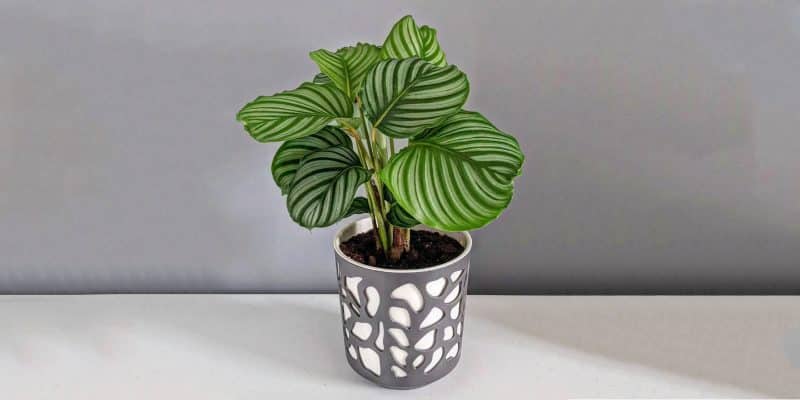Welcome to the captivating world of Calathea orbifolia – a mesmerizing houseplant that enchants with its stunning foliage and intricate patterns!
Now classified as Goeppertia orbifolia, this tropical gem will leave you awestruck by its beauty and elegance. But, the question remains – how do you keep this gorgeous green goddess happy in your home?
Fear not!
In this comprehensive guide, we’ll take you on a journey through the fascinating life of Calathea orbifolia, unveiling its unique characteristics and mysterious nighttime habits. We’ll share our secrets on providing the best care, covering everything from lighting to humidity, and from soil to propagation.
Plus, we’ll delve into common issues you might encounter and how to fix them to keep your Calathea orbifolia thriving.
So, join us on a little botanical adventure as we explore the enchanting world of Calathea orbifolia care together!
Table of Contents
Calathea Orbifolia care
History, Habitat, and Characteristics
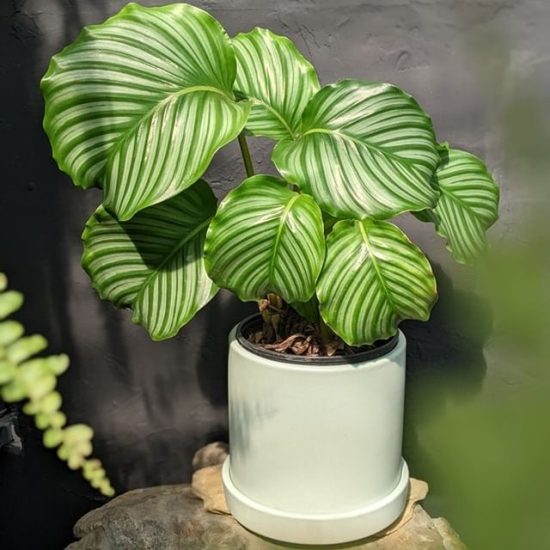
Calathea orbifolia! This charming little tropical plant, also known as Goeppertia orbifolia, hails all the way from the lush rainforests of Bolivia in South America.
With its dramatic foliage and intriguing light green appearance, it’s no wonder it has become a beloved choice for plant enthusiasts everywhere.
Part of the prayer plant family, this plant stands out from the crowd, sporting rather stylish shades of light and dark green leaves. But wait, there’s more! Have you noticed the mesmerizing zebra-like pattern of fine lines?
How about the amazing circular leaves that fold up at night and open again during the day?
Fun fact: This nighttime leaf-folding habit is actually a clever adaptation to its native rainforest habitat. By moving this way, the Calathea orbifolia plant can soak up as much sunlight as possible during the day for extensive photosynthesis, while conserving water at night when the air is cooler and more humid.
Now, you might be thinking, “Is Calathea orbifolia care high-maintenance?” Well, yes and no.
It may have a bit of a reputation, but once you familiarize yourself with its preferences (humidity, temperature, and light levels), it becomes a surprisingly low-maintenance and delightful indoor companion.
(Don’t worry, we’ll provide plenty of Calathea orbifolia care tips to help you succeed with this plant.)
Light
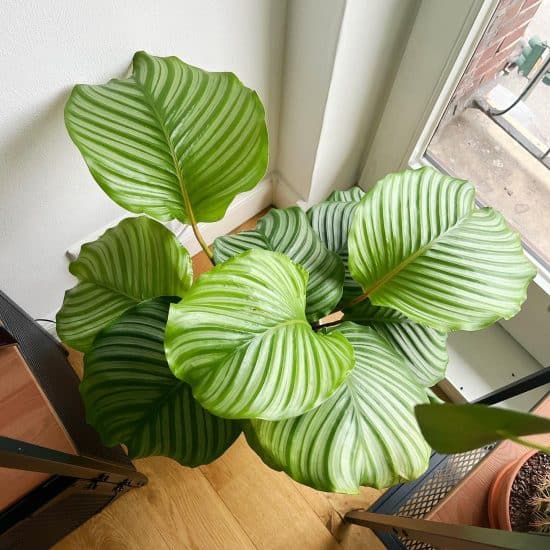
Calathea orbifolia plant care starts with really thinking about its natural habitat and trying to replicate it as closely as we can.
In nature, Calathea orbifolia plants usually grow close to the canopy floor, which means filtered light or partial shade, where sunlight isn’t too harsh.
So, what does this mean for your home?
Well, your plant will thrive in bright, indirect light. It can handle a little bit of direct sunlight too, but be careful… too much direct sun will cause the leaves to burn, curl, and start to form little brown spots.
If that’s happening, you’ll want to move your plant somewhere with more filtered light or use a sheer curtain to soften the sunlight.
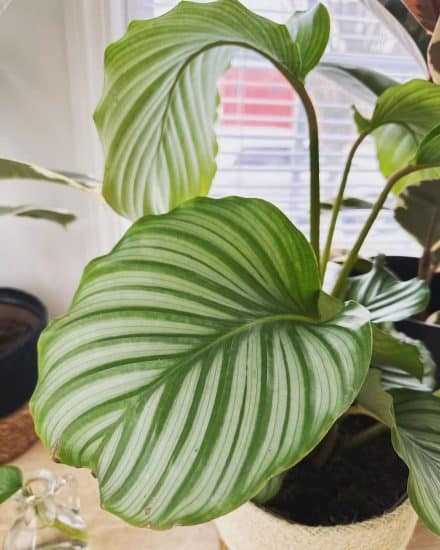
Not enough light?
You’ll notice the leaves looking a bit sad—dull, discolored, or growing at a snail’s pace. To help your plant out, try placing it close to an east or north-facing window where it can enjoy plenty of bright, indirect light without worrying about a sunburn.
Lighting tips:
- Keep it away from harsh direct sunlight, especially during the sunniest hours of the day (nobody wants crispy leaves!).
- Rotate your plant regularly to make sure all the leaves get a chance to grow evenly (they’ll thank you for it).
- Struggling to find the perfect spot? Don’t worry! You can always use an artificial light source, like a full-spectrum LED grow light.
Water
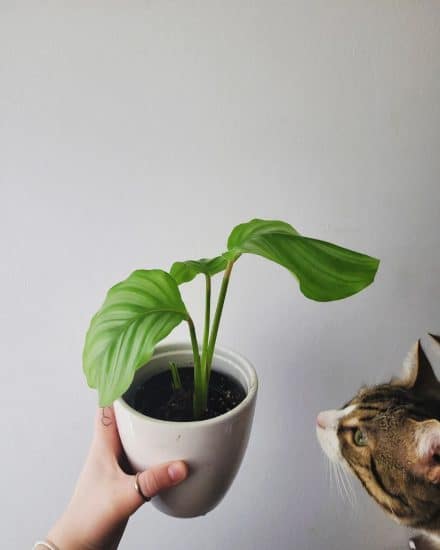
Calathea orbifolia loves moist soil, but be careful not to overdo it. To hit the sweet spot, water your prayer plant just when the top layer of soil feels dry to the touch. This might be once a week or so, but hey, each environment is different!
Now, about the water itself. Tap water usually works just fine, but if you know your house has a water softener or high chlorine levels, you might want to switch to rainwater, filtered, or distilled water.
Not enough water can dry out the leaves and make them curl up. If you see this happening, try increasing how frequently you water the plant. The amount of water should always be roughly the same.
(And don’t forget to remove any dying leaves – they can attract pests, and nobody wants that.)
On the flip side, too much water could lead to yellowing leaves, soggy stems, or even rot (you’ll notice brown tips and small brown or black spots on the leaves).
If you think you’ve been overwatering this prayer plant, just let the soil dry out before giving it another drink. You can also consider changing up the soil (we’ll cover that in a bit).
As the seasons change, your Calathea orbifolia’s watering needs might change too. During winter, it could need less water, so just keep an eye on the soil and make any necessary adjustments.
Temperature and humidity
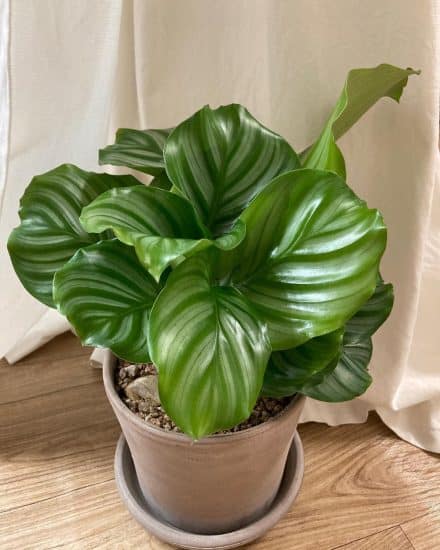
To keep your Calathea healthy and happy, we want to try our best to replicate the conditions in its natural habitat.
Prayer plants like Calathea orbifolia prefer a temperature between 65-80 degrees Fahrenheit. The plant can survive in lower temperatures but will experience stunted growth.
Keep your Calathea orbifolia plant away from drafts and cold windows, as exposure to temperatures below 65°F may lead to wilting and slower growth.
Prayer plants love high humidity, ideally between 70% and 80%. Calathea orbifolia can also adapt to outdoor humidity levels of 60 to 90% and indoor average room humidity in tropical climates.
Maintaining such high humidity levels can be tricky, so we recommend combining a few techniques. Add a small humidifier nearby, group your plants together that like high humidity, and place a pebble tray under the plant. It’s best to avoid misting the leaves, as this can lead to issues with pests and diseases.
Signs of humidity and temperature issues:
- Leaves curling or edges turning brown: This indicates that the humidity level is too low, and your plant needs more moisture in its environment.
- Wilting leaves or slow growth: These signs may suggest that the temperature is too low or inconsistent. Ensure that your plant is placed in a well-insulated space or near a consistent heat source, and avoid exposing it to drafts and cold windows.
- Scorched leaf tips or yellowing leaves: This could be a sign of extreme temperature fluctuations or excessive heat. Prayer plants like Calathea orbifolia may benefit from being moved to a cooler location away from direct heat sources, such as radiators or vents.
Soil and planting
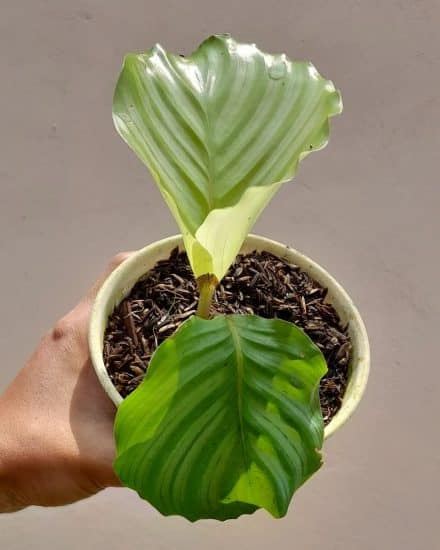
Calathea orbifolia thrives best when given a well-drained, airy potting mix that resembles the nutrient-rich forest floor. To make this, we can combine half coco peat or peat moss and half perlite, with added some additional added nutrients like orchid bark or worm castings.
This mixture gives us a well-draining soil, reducing the risk of rot in Calathea plants. You can also purchase an aroid potting mix, which will have everything in the right proportions already.
Calathea orbifolia can be grown outdoors, but make sure to place them in a location with moist soil and protection from too much light, which can cause leaf discoloration and make them vulnerable to pests.
Fertilizer
Introducing a balanced liquid fertilizer during the active growing season helps to promote new growth in Calathea plants. It’s important to start with a smaller amount of liquid houseplant fertilizer than the label suggests and then gradually increase the quantity over time.
Too much fertilizer will look like burnt or scorched leaves, yellowing, and weak growth. If you notice any of these signs, it’s time to make a few adjustments. Flush the soil with water to wash away excess nutrients, and reduce the frequency or concentration of your fertilizer.
Repotting
Calathea orbifolia doesn’t require frequent repotting, but when it’s time, the best period is during the active growing season, usually in spring and summer. Choose a container only one or two inches larger than the current pot, with sufficient drainage holes to prevent excess water from accumulating.
Remember that transplant shock can occur, so take special care when handling your Calathea orbifolia during repotting. If you notice baby clumps growing around the mother plant, these can be carefully separated and planted in their own pots to create new, young plants.
It’s a good idea to keep your Calathea in nursery pots for efficient drainage, or use a decorative pot, but ensure adequate drainage with the pot’s drainage holes or by adding a drainage layer.
Propagation guide
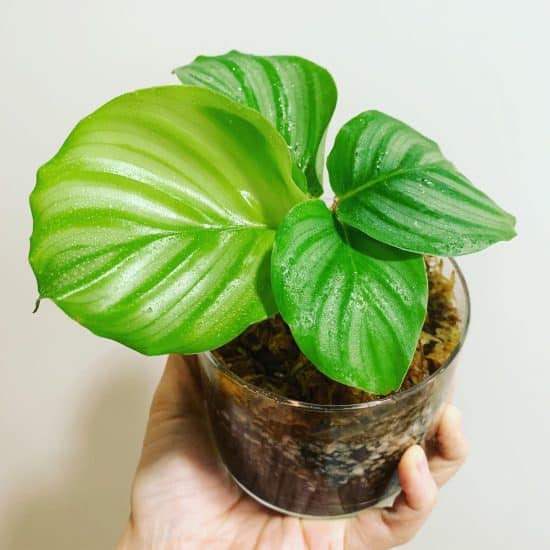
As we mentioned in the Repotting section, Calathea orbifolia is a bit picky about when it likes to be repotted, so we really suggest propagating at the same time. We’re going to divide off the mother plant into smaller sections, each with its own root system.
Stem cuttings? They’ve never really worked for us.
Propagating Calathea orbifolia by division:
First things first — you’ll need a clean, sharp pair of gardening scissors or shears, a couple of small pots so your new plants can have their own pot, and some well-draining, airy potting mix.
- Give your plant a gentle hug. Slip your fingers gently around the base of the plant and lift it out of the pot, being extra careful not to mess with those precious roots.
- Find those rhizomes. Check out Calathea orbifolia’s root system and spot the rhizomes—the horizontal stems where new growth begins. Your goal here is to divide the plant into sections, making sure each one has at least one rhizome with roots attached.
- Time for the big split. Grab your gardening shears and carefully cut off the rhizomes to separate the divisions. You’ll want each group to have a healthy root structure and nice healthy leaves, too.
- Pot your new plants. Fill each small pot with your well-draining potting mix and plant the newly separated divisions. Make sure the roots are all snug under the mix.
After potting, water your new baby plants just like you would the mother plant. Place them in a spot with plenty of light and try to maintain a consistent temperature and high humidity levels.
New plants love humidity, so you can even make a mini-terrarium with some Tupperware overhead and a pebble tray with water underneath.
Don’t stress if your new Calathea orbifolia divisions take their sweet time to grow — good things come to those who wait! Remember, growing a Calathea orbifolia can be hard, but patience pays off.
Common issues
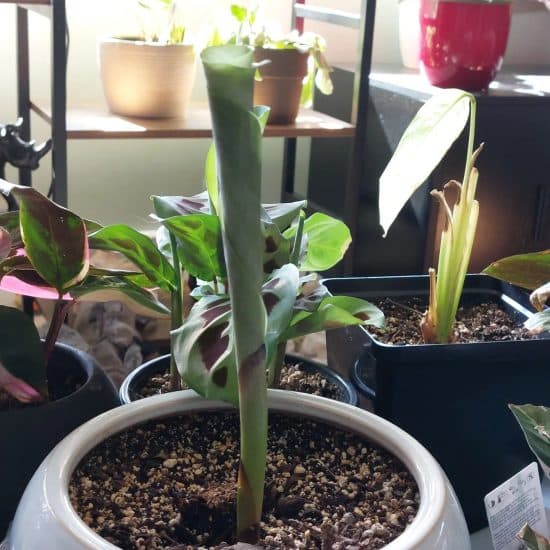
Just like all indoor plants, Calathea orbifolia can have its ups and downs. Let’s chat about three common problems you might face, along with some helpful tips on how to identify and fix them.
Crispy Leaf Tips
This might be due to under-watering or low humidity. To help your plant out, try to water it consistently when the top inch of soil feels dry.
And let’s not forget about humidity! Place a tray of water near your plant or use a humidifier to give it the tropical vibe it loves.
If you’re pretty sure humidity and the amount of water are both right, you’ll want to switch to distilled, filtered, or rain water. Calathea can be sensitive to some impurities in water.
Brown Patches
That could be a sign of too much direct light (they prefer to keep it indirect). If these patches keep popping up, maybe it’s time to play interior designer and move your plant to a spot with less direct light… or you can simply filter the sunlight with a fancy sheer curtain.
Remember to give your plant a little twirl now and again to make sure all its leaves get their fair share of light.
Yellowing Leaves
Yellow leaves are almost always caused by an issue with water, typically overwatering, with Calathea orbifolia plants.
But don’t worry, we can fix this!
Let’s look at watering habits — are you letting the soil dry slightly between waterings? Calathea orbifolia plants prefer consistently moist soil, but not soggy.
To achieve this balance, allow the top inch of soil to dry out before watering again. A good rule of thumb is to water your plant when you can stick your finger about an inch into the soil and it feels dry.
If the pot lacks drainage holes or has too few, water can become trapped at the bottom, leading to lots of issues. Ensure your plant is potted in a container with adequate drainage holes and use a well-draining soil mix, which typically includes ingredients like perlite, bark, or coco coir.
Lastly, inspect the roots to determine their health. Carefully remove your Calathea orbifolia from its pot and examine the root system. Healthy roots should appear white or light tan and feel firm to the touch.
If you notice mushy, brown, or foul-smelling roots, your plant may be suffering from rot, which we’ll cover in the next section.
Pests and diseases
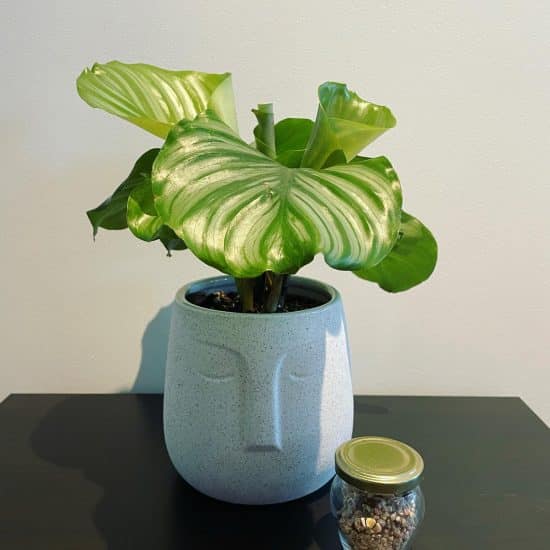
Spider mites
Spider mites can be a bit of a nuisance for your Calathea orbifolia… but don’t worry! We’ve got the lowdown on how to deal with these pesky critters.
These tiny troublemakers look like minuscule white or brown dots on the underside of your plant’s leaves. They often spin web-like structures between leaves and stems, which is a telltale sign you’ve got a spider mite problem.
If you spotted some spider mites, first, isolate your beloved Calathea (we don’t want those mites spreading!). Next, use a damp cloth to gently wipe both sides of the leaves, getting rid of as many mites as you can.
Then, it’s time to treat your plant with insecticidal soap or neem oil spray. Just remember to reapply every seven to ten days to ensure complete elimination.
Regularly clean your Calathea orbifolia’s leaves with a damp cloth to remove dust and keep those mites away.
Root rot
Root rot is a common (and dreaded) problem for indoor houseplants, including Calathea orbifolia.
Here’s the scoop: root rot happens when your plant’s roots are soaking in too much water (think overwatering or poor drainage). You’ll know you’ve got a case of root rot if the roots are looking mushy, slimy, and dark brown or black.
If so, it’s time to nurse your Calathea back to health. Remove your plant from its pot, trim away the affected roots with sterilized scissors (don’t forget to sterilize them before and after!), and let the plant air-dry for a few hours. Repot it in fresh soil with good drainage, and you’re on your way to recovery.
Focus on well-draining soil and a pot with proper drainage. Only water your Calathea orbifolia when the top two inches of soil are dry, and never leave your plant sitting in water (that’s just asking for rot!).
Conclusion
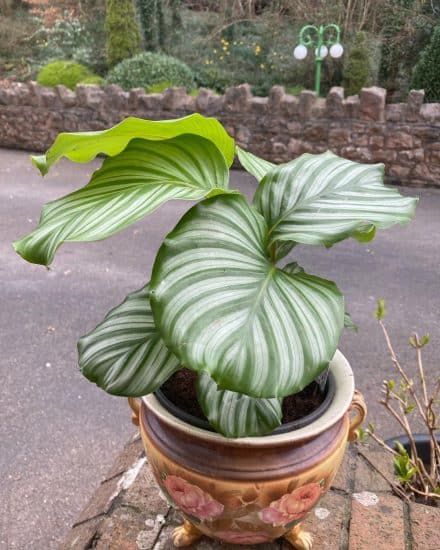
That’s it for our Calathea orbifolia care guide!
Embrace the beauty of this Bolivian gem by providing the right care for your indoor companion, and it will reward you with mesmerizing foliage and a stunning presence in your home.
Calathea orbifolia care summary:
- Place your plant in bright light, but protect it from direct sunlight to avoid scorching the leaves.
- Maintain consistent watering by allowing the top layer of soil to dry out before watering again, but avoid overwatering to prevent root rot.
- Keep your plant in an environment with temperatures between 65-80°F (18-26°C) and high humidity levels around 70-80%.
- Choose a well-draining potting mix that replicates its natural habitat, and repot only when necessary, usually during the active growing season.
You should now have everything you need to help you care for your Calathea orbifolia.
If you have any questions, don’t hesitate to reach out to us. And if this guide was helpful to you, feel free to share it with fellow plant enthusiasts!
Take care!
FAQ
Can Calathea orbifolia grow in low light?
Calathea orbifolia isn’t a huge fan of low-light conditions. In nature, it thrives in bright, indirect light near the forest floor. In your home, it will be much happier near an east or north-facing window, where it can soak up plenty of indret light. While it might survive in low light, don’t expect your Calathea orbifolia to be at its best. If you’re struggling to find the perfect spot, consider adding a grow light.
Is Calathea orbifolia toxic to pets?
When it comes to toxicity, Calathea orbifolia equals good news: it’s not toxic to pets. The ASPCA classifies this plant as non-toxic to cats and dogs. While it’s always best to keep your pets from nibbling on your houseplants, you can breathe a sigh of relief knowing that your fur babies are safe.
How do you take care of Calathea orbifolia in the winter?
While it’s still important to provide plenty of bright light in winter, you may notice the plant needs less water. Keep an eye on the soil moisture, making sure it’s consistently moist but not waterlogged. The cooler temperatures and dry indoor air might mean your Calathea orbifolia craves higher humidity. And, as always, keep your plant away from drafts and cold windows to prevent wilting or slowed growth.
Does Calathea orbifolia flower indoors?
While it’s true that Calathea orbifolia can produce flowers, it’s relatively rare for this houseplant to bloom indoors. In its natural habitat, the Calathea orbifolia would produce small white or purple flowers near the base of the plant.
However, indoors, it’s more common for the plant to focus its energy on producing those gorgeous, eye-catching leaves. So while you might not see flowers on your indoor Calathea orbifolia, you’ll still enjoy the stunning foliage, which is a showstopper in its own right!

